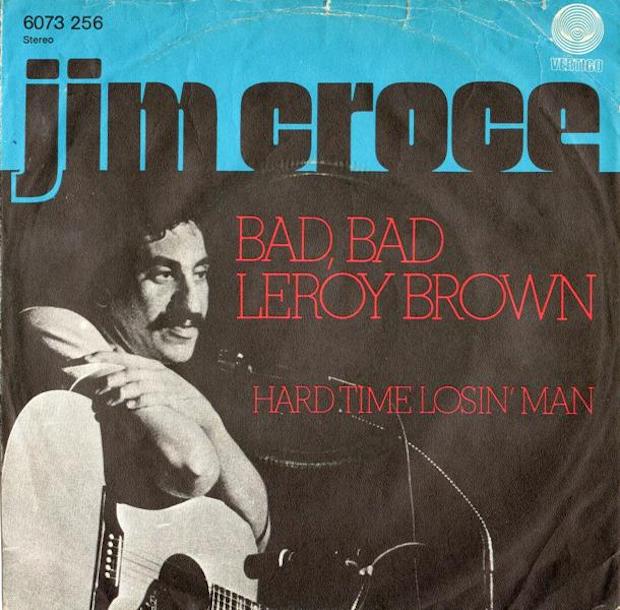In The Number Ones, I'm reviewing every single #1 single in the history of the Billboard Hot 100, starting with the chart's beginning, in 1958, and working my way up into the present.
Jim Croce - "Bad, Bad Leroy Brown"
HIT #1: July 21, 1973
STAYED AT #1: 2 weeks
There really was a Leroy Brown. After Jim Croce got done with college, he signed up for the National Guard to avoid getting drafted and sent to Vietnam. At his South Carolina base, Croce met a Leroy Brown. The two got along and liked singing together. But Leroy Brown didn't much like the National Guard, so he went AWOL. Then, a week later, Leroy Brown came back, thinking he could pick up his paycheck, and he got himself arrested instead. That's the story Croce told, anyway.
The Leroy Brown who Croce knew didn't really have anything to do with the Leroy Brown of "Bad, Bad Leroy Brown." In Croce's song, Leroy Brown went from a hapless National Guardsman to a legendary Chicago tough guy -- a towering and intimidating figure with crisp clothes, fancy cars,expensive jewelry, and weapons concealed on his person. But as with the real Leroy Brown, Croce seems to consider the Leroy Brown of the song a slightly ridiculous figure. And like the real Leroy Brown, the Leroy Brown of the song makes a bad decision, and he pays for it.
Croce had grown up in Italian enclaves in and around Philadelphia, and he hadn't started making music until he was in college at Villanova. There, he met his wife Ingrid, and they spent some time trying to break into the music business together. For years, it didn't work out, and Croce worked shit jobs -- construction, driving trucks, an eventual gig selling commercials for a Philly radio station. After years of struggling, Croce got himself signed to ABC, and his first big-label solo album, 1972's You Don't Mess Around With Jim, did business. (The title track peaked at #8. It's a 6.) So Croce quickly cranked out another one, releasing Life And Times a little more than a year later and leading it off with a single that was basically a rewritten version of "You Don't Mess Around With Jim."
"Bad, Bad Leroy Brown" moves the action from New York to Chicago, but the contours of the story are familiar. We meed this mythic bad-man figure, and then we watch as this outlaw gets into a fight with the wrong person and finds himself on the wrong end of a knife. Most of Croce's songs were sensitive, plainspoken folkish-type things, but he sure seemed to like this particular construction. At first, "Bad, Bad Leroy Brown" seems to fit squarely within the "this guy's a badass" lineage, a tradition of story-songs that yielded #1 hits as diverse as "Stagger Lee," "Alley Oop," "Big Bad John," and "The Ballad Of The Green Berets." But Leroy Brown isn't really a badass at all. He's Stagger Lee getting staggered.
One thing about "Bad, Bad Leroy Brown" that's rarely remarked-upon: It's never specified, but it seems pretty obvious that Leroy Brown is black. He's a stereotype, a slick Chicago gangster who chases women even when it's not wise and who turns out to not be as tough as he thinks. The song has a sort of boogie-woogie blues beat; it sounds like white guys trying to sound black. Croce sings in a clumsy imitation of black English: "Now Leroy, he a gambler." It's not that the song is racist, exactly. Standards were different in 1973, and there's certainly no hostility in the way Croce sings the song. But it's the sort of extended joke that would not go unexamined today. In 2014, shortly after a police officer killed the unarmed teenager Michael Brown in Ferguson, some asshole in California sang a racist parody of "Bad, Bad Leroy Brown" for a bunch of cops at an Elks Club benefit in California. Jim Croce pretty clearly didn't have anything like that in mind when he wrote the song, but "Bad, Bad Leroy Brown" probably leaves itself a little too open to that type of interpretation.
Maybe that would be easier to forgive if the song was better. But it's a clumsy, lurching bluesy thing with a basic-ass groove and a whole lot of piano and slide-guitar noodling around that groove. It's well-recorded, in that slick '70s studio-pop way, and Croce delivers it with the right combination of energetic silliness and arch distance. The writing is clear and evocative: "Leroy looked like a jigsaw puzzle with a couple of pieces gone." And the song is catchy, to the point where it's hard to stop it once it starts rattling around inside your mind. But it's also dumb and obvious and unpleasant.
"Bad, Bad Leroy Brown" ended up resonating anyway. Two different successful pro wrestlers, Bad Leroy Brown and the Junkyard Dog, took their names from the song. (The history of pro wrestling is another thing that starts to look grosser when you spend even a half-second looking at the racial dynamics at play.) And Queen -- a band who will show up in this column with a couple of songs, including the one that served as the Junkyard Dog's original entrance music -- followed up on it with 1974's "Bring Back That Leroy Brown," a song that they recorded shortly after Croce died in a plane crash. But we'll get to that.
GRADE: 3/10
BONUS BEATS: Here's the bit from the extremely entertaining 1992 heist-caper movie Sneakers where the house band at a Chinese restaurant covers "Bad, Bad Leroy Brown":
BONUS BONUS BEATS: Ol' Dirty Bastard's classic 1995 debut Return To The 36 Chambers: The Dirty Version featured "Snakes," a RZA/Masta Killa/Killah Priest/Buddha Monk posse cut that climaxes when Dirty warbles the hook from "Bad, Bad Leroy Brown." Here's that:
(Ol' Dirty Bastard never had a top-10 single on the Hot 100, but he did rap on the probably-more-popular-than-the-original remix of a song that'll eventually appear in this column.)
THE 10S: Three Dog Night's ecstatic mystic-gospel singalong "Shambala" peaked at #3 behind "Bad, Bad Leroy Brown." It's a 10.






